Urinary bladder function and somatic sensitivity in vasoactive intestinal polypeptide (VIP)-/- mice
- PMID: 18561033
- PMCID: PMC2693375
- DOI: 10.1007/s12031-008-9100-8
Urinary bladder function and somatic sensitivity in vasoactive intestinal polypeptide (VIP)-/- mice
Abstract
Vasoactive intestinal polypeptide (VIP) is an immunomodulatory neuropeptide widely distributed in neural pathways that regulate micturition. VIP is also an endogenous anti-inflammatory agent that has been suggested for the development of therapies for inflammatory disorders. In the present study, we examined urinary bladder function and hindpaw and pelvic sensitivity in VIP(-/-) and littermate wildtype (WT) controls. We demonstrated increased bladder mass and fewer but larger urine spots on filter paper in VIP(-/-) mice. Using cystometry in conscious, unrestrained mice, VIP(-/-) mice exhibited increased void volumes and shorter intercontraction intervals with continuous intravesical infusion of saline. No differences in transepithelial resistance or water permeability were demonstrated between VIP(-/-) and WT mice; however, an increase in urea permeability was demonstrated in VIP(-/-) mice. With the induction of bladder inflammation by acute administration of cyclophosphamide, an exaggerated or prolonged bladder hyperreflexia and hindpaw and pelvic sensitivity were demonstrated in VIP(-/-) mice. The changes in bladder hyperreflexia and somatic sensitivity in VIP(-/-) mice may reflect increased expression of neurotrophins and/or proinflammatory cytokines in the urinary bladder. Thus, these changes may further regulate the neural control of micturition.
Figures
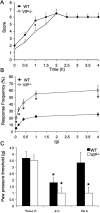

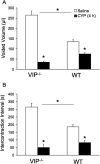
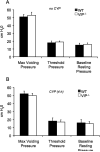
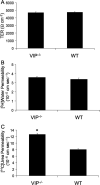
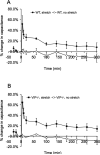
Similar articles
-
Effects of CYP-induced cystitis on PACAP/VIP and receptor expression in micturition pathways and bladder function in mice with overexpression of NGF in urothelium.J Mol Neurosci. 2012 Nov;48(3):730-43. doi: 10.1007/s12031-012-9834-1. Epub 2012 Jun 15. J Mol Neurosci. 2012. PMID: 22700375 Free PMC article.
-
Exaggerated expression of inflammatory mediators in vasoactive intestinal polypeptide knockout (VIP-/-) mice with cyclophosphamide (CYP)-induced cystitis.J Mol Neurosci. 2008 Nov;36(1-3):188-99. doi: 10.1007/s12031-008-9084-4. Epub 2008 May 16. J Mol Neurosci. 2008. PMID: 18483878 Free PMC article.
-
PACAP/VIP and receptor characterization in micturition pathways in mice with overexpression of NGF in urothelium.J Mol Neurosci. 2010 Nov;42(3):378-89. doi: 10.1007/s12031-010-9384-3. Epub 2010 May 7. J Mol Neurosci. 2010. PMID: 20449688 Free PMC article.
-
The role of vasoactive intestinal polypeptide and pituitary adenylate cyclase-activating polypeptide in the neural pathways controlling the lower urinary tract.J Mol Neurosci. 2008 Nov;36(1-3):227-40. doi: 10.1007/s12031-008-9090-6. Epub 2008 Aug 2. J Mol Neurosci. 2008. PMID: 18677446 Free PMC article. Review.
-
Mechanisms underlying the recovery of lower urinary tract function following spinal cord injury.Prog Brain Res. 2006;152:59-84. doi: 10.1016/S0079-6123(05)52005-3. Prog Brain Res. 2006. PMID: 16198694 Review.
Cited by
-
Parkinsonian GM2 synthase knockout mice lacking mature gangliosides develop urinary dysfunction and neurogenic bladder.Exp Neurol. 2019 Jan;311:265-273. doi: 10.1016/j.expneurol.2018.10.014. Epub 2018 Oct 25. Exp Neurol. 2019. PMID: 30393144 Free PMC article.
-
Transcriptional and translational plasticity in rodent urinary bladder TRP channels with urinary bladder inflammation, bladder dysfunction, or postnatal maturation.J Mol Neurosci. 2012 Nov;48(3):744-56. doi: 10.1007/s12031-012-9867-5. Epub 2012 Aug 5. J Mol Neurosci. 2012. PMID: 22865090 Free PMC article.
-
Effects of CYP-induced cystitis on PACAP/VIP and receptor expression in micturition pathways and bladder function in mice with overexpression of NGF in urothelium.J Mol Neurosci. 2012 Nov;48(3):730-43. doi: 10.1007/s12031-012-9834-1. Epub 2012 Jun 15. J Mol Neurosci. 2012. PMID: 22700375 Free PMC article.
-
Urothelial Tight Junction Barrier Dysfunction Sensitizes Bladder Afferents.eNeuro. 2017 May 24;4(3):ENEURO.0381-16.2017. doi: 10.1523/ENEURO.0381-16.2017. eCollection 2017 May-Jun. eNeuro. 2017. PMID: 28560313 Free PMC article.
-
PACAP/Receptor System in Urinary Bladder Dysfunction and Pelvic Pain Following Urinary Bladder Inflammation or Stress.Front Syst Neurosci. 2017 Dec 4;11:90. doi: 10.3389/fnsys.2017.00090. eCollection 2017. Front Syst Neurosci. 2017. PMID: 29255407 Free PMC article. Review.
References
-
- Abad C, Martinez C, Juarranz MG, et al. Therapeutic effects of vasoactive intestinal peptide in the trinitrobenzene sulfonic acid mice model of Crohn's disease. Gastroenterology. 2003;124:961–971. - PubMed
-
- Abbadie C. Chemokines, chemokine receptors and pain. Trends Immunol. 2005;26:529–534. - PubMed
-
- Anderson LC, Rao RD. Interleukin-6 and nerve growth factor levels in peripheral nerve and braistem after trigeminal nerve injury in the rat. Arch. Oral Biol. 2001;46:633–640. - PubMed
-
- Bielefeldt K, Lamb K, Gebhart GF. Convergence of sensory pathways in the development of somatic and visceral hypersensitivity. Am. J. Physiol. Gastrointest. Liver Physiol. 2006;291:G658–665. - PubMed
-
- Bik W, Wolinska-Witort E, Chmielowska M, Baranowska-Bik A, Rusiecka-Kuczalek E, Baranowska B. Vasoactive intestinal peptide can modulate immune and endocrine responses during lipopolysaccharide-induced acute inflammation. Neuroimmunomodulation. 2004;11:358–364. - PubMed
Publication types
MeSH terms
Substances
Grants and funding
LinkOut - more resources
Full Text Sources
Medical

